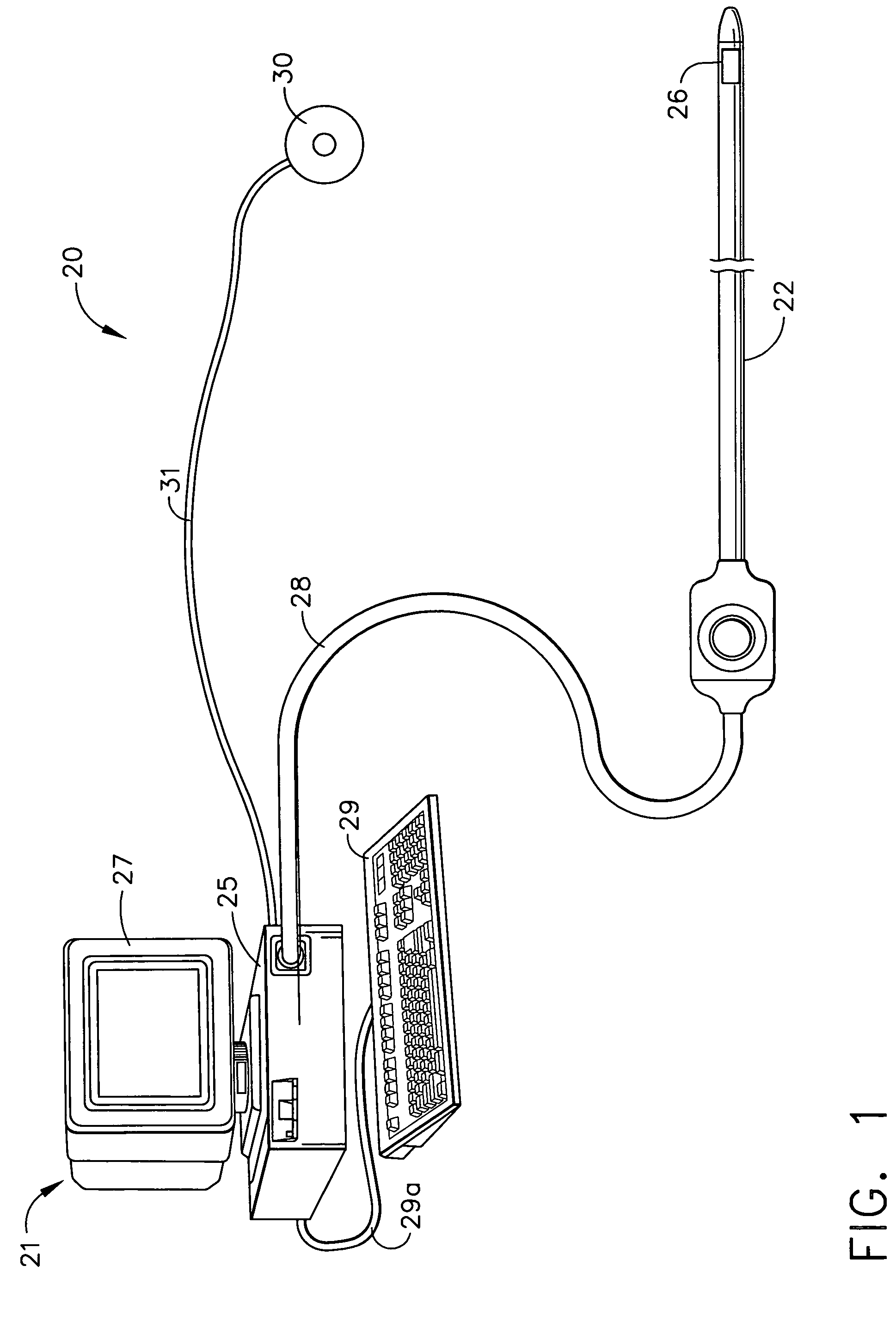Medical system calibration with static metal compensation
a technology of static metal compensation and medical system, applied in the field of noncontact electromagnetic medical system, can solve the problem of no known system or method, and achieve the effect of reducing variability in calibration
- Summary
- Abstract
- Description
- Claims
- Application Information
AI Technical Summary
Benefits of technology
Problems solved by technology
Method used
Image
Examples
first embodiment
[0063]System 20 further comprises radiator elements or coils 32, 34, 36, 38, 40, 42, 44, 46, and 48 (also known as generator coils). In one embodiment, the coils are wound in sets of three orthogonal and concentric coils forming radiators 56, 58, and 60, respectively. Preferably, the coils 32, 34, 36, 38, 40, 42, 44, 46, and 48 are each wound around a support member such as a spool. In this first embodiment, each radiator 56, 58 and 60 has three coils that are co-located. Accordingly, the coils of each radiator are concentric with each other and mutually orthogonal with each other. The concentric arrangement is accomplished by having each coil within a particular radiator shaped such that the coils with their respective support member each have a different diameter. For instance, by way of example with respect to radiator 56, coil 36 accommodates and receives coils 32 and 34 and coil 34 accommodates and receives coil 32. Thus, coil 36 (with its support member) has a diameter that is...
fourth embodiment
[0068]FIG. 9 illustrates a radiator arrangement in accordance with the present invention. In this embodiment, radiators 56c, 58c and 60c comprise a co-located arrangement for the radiator coils 32, 34, 36, 38, 40, 42, 44, 46 and 48 respectively wherein the coils of each radiator are concentric with respect to each other similar to the radiator embodiment of FIG. 2. However, the coils of each radiator 56c, 58c and 60c are are not orthogonal to each other. Again, the only limitation to the coil orientations is that one coil is not parallel to another coil in a particular radiator arrangement 56c, 58c and 60c.
[0069]Position and Orientation Method
[0070]FIG. 3 is a schematic flow chart illustrating a method and associated algorithmic components for determining the coordinates of sensing coil 26, in accordance with a preferred embodiment of the present invention. The general method steps will be described below and the specific steps of the novel algorithm will be described in detail lat...
second embodiment
[0198]the calibration method according to the present invention utilizes extrapolation of the magnetic field at the next point. As shown in FIG. 13, in particular, first, the metallic object is placed within the intended mapping volume. Again, the robot arm 110 positions the sensor 100 at the first point 210 (starting or first position Xi, Yi, Zi) and the magnetic field at this first point is read and measured by the signal processor 25 to determine the first coordinate position. Next, the signal processor 25, extrapolates the magnetic field at the next or second point 220, e.g. next or second coordinate position (next vertex of mapping cube 200a which is the extrapolated point) defined as (Xi=Xi+dx, Yi=Yi+dy, Zi=Zi+dz) which includes the added distance component dx, dy, dz as appropriate. In this case, the added distance component (dx) is a 3 cm distance along the X coordinate axis.
[0199]Once the magnetic field for the second point (the next point) is extrapolated, the location coo...
PUM
 Login to View More
Login to View More Abstract
Description
Claims
Application Information
 Login to View More
Login to View More - R&D
- Intellectual Property
- Life Sciences
- Materials
- Tech Scout
- Unparalleled Data Quality
- Higher Quality Content
- 60% Fewer Hallucinations
Browse by: Latest US Patents, China's latest patents, Technical Efficacy Thesaurus, Application Domain, Technology Topic, Popular Technical Reports.
© 2025 PatSnap. All rights reserved.Legal|Privacy policy|Modern Slavery Act Transparency Statement|Sitemap|About US| Contact US: help@patsnap.com



